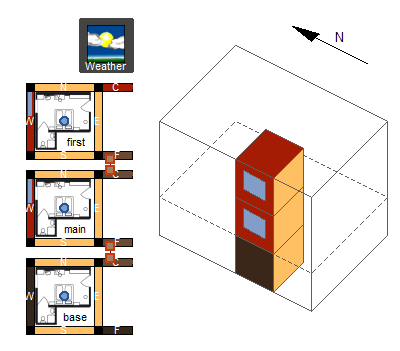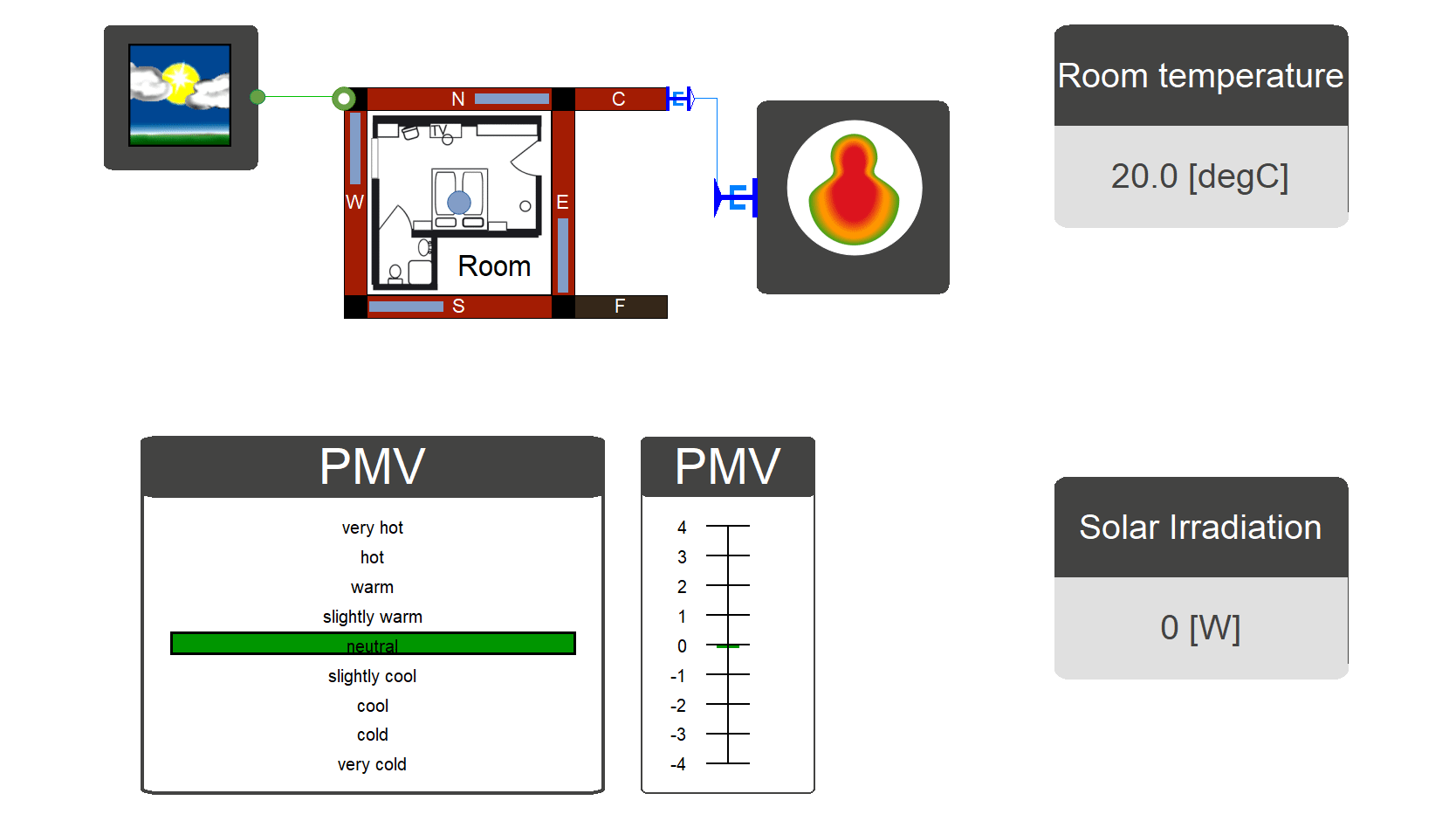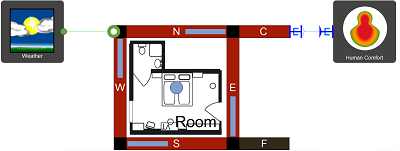HumanComfort Library
Mathematical calculations of thermal comfort and air-conditioned spaces
Energy systems are optimized in accordance with economic criteria. From the view of a user of an air conditioning/heating system the thermal comfort is very often of more importance. How the thermal comfort changes with personal and thermal factors was examined in several studies and put into classification numbers. Standardized calculation methods of these numbers were developed and allow a detailed analysis of the human comfort.
The HumanComfort Modelica library contains models which allow a mathematical evaluation of the thermal comfort. Its modular structure and the standardized interfaces make a flexible implementation in other Modelica libraries possible.
Every HumanComfort module can be exchanged. Thus, the user can combine his own building model with the HumanComfort Library and use e.g. the HumanComfort weather and comfort model. Additionally, individual room or cabin models can be built with the components from the HumanComfort Library.
Simultaneous dynamic simulation of conditioned zones and air conditioning

Analysis of interactions of air conditioning and dynamic zones effects
The models of the HumanComfort Library can be used to optimize the development of air conditioning systems of vehicles and buildings.
The HumanComfort Library allows the simultaneous dynamic simulation of conditioned zones and air conditioning contrary to the previous state of the art (see info box below). The analysis of interactions of air conditioning and dynamic zones effects is possible.
Analysis how the failure of the air conditioning affects the human comfort can be made by simultaneously simulating the building and the air conditioning.
Moreover, the performance decrease due to environmental changes and its effects on the comfort can be estimated with the HumanComfort Library.
Thus, the HumanComfort Library supports the optimal control of an air conditioning system (e.g. heat pumps, solar supported air conditioning, etc.).
HumanComfort Package
Calculation of internal zone conditions and development of control strategies for all comfort requirements
The HumanComfort Package contains the calculation methods and classification numbers to determine the comfort of a room, building or vehicle. The most usual calculation standards were combined to a complete analysis of the thermal comfort.The following standards and rules are considered:
- DIN EN ISO 7730
- ASHRAE Standard 55
- Dutch Thermal Comfort Guideline
The HumanComfort Modelica Library allows comprehensive comfort analysis by integration of the HumanComfort module. Additionally, the calculated classification numbers can already be used during the simulation to optimize the control. With that it becomes possible to develop control strategies which meet the comfort requirements.
Weather Package
Modelling of Climate Conditions
The integrated weather model is able to read arbitrary weather data and commit it to the zone model. Moreover, the model can convert the intensity of radiation to the effective area according to its spatial orientation. All necessary weather information are bundled and sent to the zone model via a standardized weather connector.
The weather connector contains the following data:
- Ambient Temperature
- Ground temperature
- Global irradiation on a horizontal surface
- Direct irradiation on a horizontal surface
- Diffusive radiation on a horizontal surface
- Ambient pressure
- Ambient humidity
- Sun position
The Zone Package contains models to develop stationary or mobile applications. Mobile applications will be built with models e.g. for aircraft or vehicle cabins. All models can individually be built and fitted. The Modelica Code is open and not encrypted.
To use the Zone package for stationary applications, a building simulation is provided within the HumanComfort Modelica library. Every zone can be combined with a weather and a HumanComfort module (see figure).

Multi-room models are built of single room models which are connected with Modelica fluid or thermal connectors (see figure).
The zone models account the following phenomena:
- Solar irradiation
- Heat transfer through walls and windows
- Head conduction
- Heat transfer caused by air exchange
- Thermal activation of wall layers
All zone models can be parameterized with different material properties and the user behavior can be simulated. (heat, humidity and CO2 sources).The air zones can be simulated with dry or moist air and in addition CO2 can be regarded
The zone models are supplemented by detailed examples of buildings, vehicles and aircrafts.
CFD Package
Calculation of air flows using Navier-Stokes equations
The CFD package contains a Modelica-based, three-dimensional grid model. The model is composed of cubic cells. Each cell, which is used to apply the finite-volumen-method, may represent a solid or an air cell. The energy and mass balances are calculated in energy cells, while the mass and heat flows are calculated in the so-called flow cell. Here, the influence of the turbulence, the shear forces acting to the air, the gravity and the buoyancy force is taken into account. By using the Navier-Stokes equations, as found in CFD simulation software, realistic flow conditions can be calculated.
At the edges of the grid standard interfaces allow an easy connection with models from other libraries. Thus, e.g. a whole building can be represented by one-dimensional wall models from the Zones package connected to the interior represented by the CFD grid model. On demand one can easily exchange the grid model with a lumped volume model for the air side. Of course Modelica.Fluid interfaces of the Modelica Standard Library are also available. Moreover, symmetric and periodic boundary conditions can be defined in order to reduce the computational effort for larger rooms.
Furthermore, the grid model contains all geometric information about the radiation exchange between surfaces. Thus, in advance the view factors to determine the thermal radiation between the surface pairs are calculated by the software, which is required to determine for example internal shading. The spacing and relative orientation of the surfaces are relevant for the exchanged heat radiation.
The pre- and postprocessing of CFD simulations is assisted by the complementary XRG Score lite software which must be requested separately. The tool is provided as MS Excel-Addin and for Windows platforms. Either single or floating licenses are available corresponding to the purchased HumanComfort license. Please write your requests to score@xrg-simulation.de.
Available for:
- 3DS Dymola
- OpenModelica (without CFD package and applications)
- Modelon Impact (without CFD package and applications)
HumanComfort Library® is a registered trademark of XRG Simulation GmbH.



